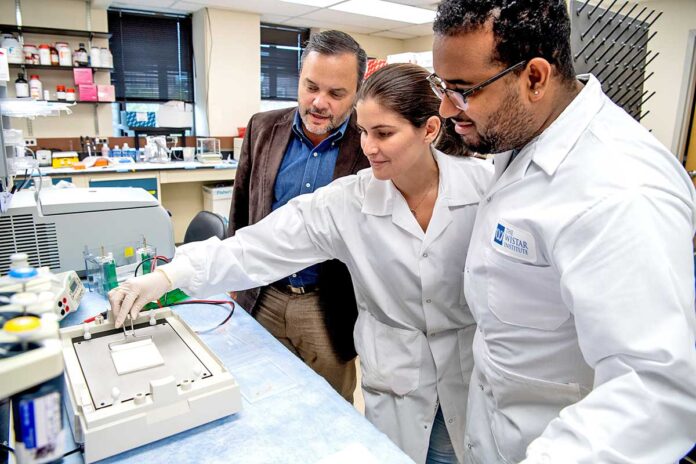Scientists at The Wistar Institute in Philadelphia recently published a paper on the benefits of employing a community engagement group (CEG) model to advance HIV cure-related research. Three components make up the CEG: the scientific team, a community-based organization — the HIV/AIDS service organization Philadelphia FIGHT in this case — and a community advisory board (CAB). At the Wistar lab, the CEG has been in use for several years.
The paper, “Community engagement group model in basic and biomedical research: lessons learned from the BEAT-HIV Delaney Collaboratory towards an HIV-1 cure,” was published in the journal “Research Involvement and Engagement” in June. The BEAT-HIV Delaney Collaboratory, which includes The Wistar Institute, is a group of more than 100 HIV research scientists from top academic research institutions who collaborate with the government, nonprofit organizations and industry partners to carry out cure-directed research for HIV.
Very few research groups utilize the CEG model, said Luis Montaner, D.V.M., D.Phil. Montaner is the vice president of Scientific Operations, Herbert Kean, M.D., family professor, director of the HIV-1 Immunopathogenesis Laboratory and leader of the HIV Research Program, Vaccine & Immunotherapy Center at The Wistar Institute.
“The main benefit is that it brings [together] community as partners to move the research forward,” Montaner said.
In a traditional community advisory board model, Montaner explained, a group of community leaders unite, learn about the research and provide advice on the research trajectory to ensure it stays compatible with the needs of the community.
“In the CEG model, the CAB expands its role to not only being advisers but also being working members of a larger group,” Montaner added. “They’re expected to contribute to the overall direction of the research and how the community is being engaged, not just providing advice and consultation. Because you bring everyone to the table, there’s a larger sense of trust in the research effort, more community awareness because they’re part of it, they’re not just secondary to what already is happening.”
Another pro of using the CEG model, according to the paper, is that the community-based organization component of the CEG helps facilitate more trust between the scientists and the CAB members, which results in more productive conversations. The CEG model provides a space for community members of color to work to counter community mistrust in HIV care providers, which is high in communities of color, the paper says; and improves unequal power dynamics that have historically posed problems for some CABs by acknowledging each leg of the CEG as an active participant.
“This is a very unique, dynamic model because we are all working together,” William B. Carter, chairman of the BEAT-HIV Community Advisory Board, said in a press release. “We work in unison with researchers and Philadelphia FIGHT and it’s a beautiful thing. In my eyes, the scientists dream up the roadmap to implement cure research with collaborators. And then the community makes the dream our own. The scientists’ dreams will never come to light because they can’t take that injection. They can’t take that pill. You need health clinics and services to help organizations. Then you need us. I don’t see how we can’t succeed.”
The CEG is also responsible for the BEAT-HIV Home-Based Viral Load Acceptability study, which involved the testing of an experimental at-home blood collection device that could require fewer visits to clinics to monitor viral loads of patients during trials. CAB community members were engaged at all stages of the research process, according to the paper, from providing opinions on research design to getting the results out into the community as part of FIGHT’s 2022 HIV Prevention Summit.
Other positive results of the CEG include social science projects to determine the acceptability of strategies under consideration for an HIV cure, educational videos published on the BEAT-HIV Delaney Collaboratory website and position papers on possible impacts the research may have on people participating in cure-directed trials.
“There’s been very specific deliverables that have come from this group,” Montaner said. “We have been able to put this model to work and generate very specific products because of it.”
The CEG model involved some challenges, Montaner said, one of which is that community advisors who are putting in a lot of time and effort to the CEG should be compensated for their work.
“We’re in the process of expanding this to include the community consultants within the CEG, because that would allow us to move people from the CAB into consultants and be able to remunerate them for the time that they’re putting into the project building,” Montaner said.
Other challenges that have emerged from using the CEG method, according to the paper, include the need to clearly communicate to prospective trial participants that it is unlikely they will directly benefit from the research in the near future; to make sure that community input is actually applied and not just acknowledged; to maintain CEG rules of engagement and proper conflict resolution; and to define and redefine roles and responsibilities.
The CEG team also learned that there is a need to inform HIV care providers about the status of HIV treatment options and cure trials so they can properly inform consumers.
“We still grapple with the issue that a lot of community members think that there’s a cure when there isn’t a cure,” Montaner said. “We need to educate and try to set facts straight about what is known and what is investigation versus what is available so there’s a real sense of accurate information in the community. There’s a lot that we still need to do moving forward, not just with the research but with the community involved with the research.”
Down the line, Montaner hopes the CEG model “inspires the [National Institutes of Health] and the government to consider this model more broadly for all the other collaboratories, not just ours. I think there’s a lot more power to this from a larger implementation.”
